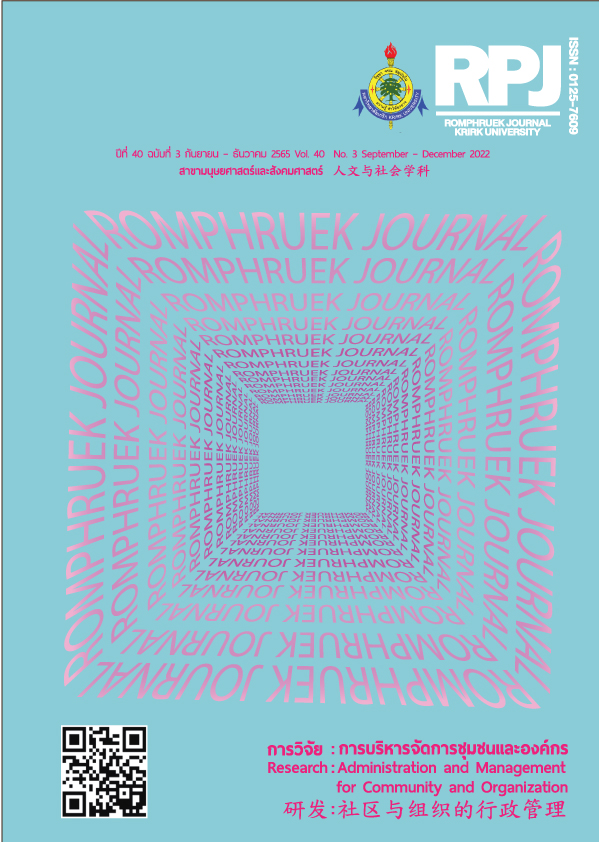The representation of Goddess Kali in an Esports Game, ROV and Goddess Kali in Hindu Mythology
Main Article Content
Abstract
This article aimed to study the representation of the Goddess Kali in an esports game, ROV and the Goddess Kali in Hindu mythology. The objective of this article was to study and find the representation of the Goddess Kali for an analysis. The research was conducted through documentary research and descriptive analysis. The results revealed that Garena, a company in Singapore and the largest online game manufacturer in ASEAN, adopted the information from Hindu mythology concerning the Goddess Kali to create the hero character in an esports game, ROV, which is currently popular among Generation Y and Generation Z. The Goddess Kali is believed in Hindi mythology to be the fiercest part of Uma Devi, the consort of Lord Shiva, and she reincarnated to defeat the demon. According to the study, there appeared to be five representations consisting of 1) the representation of the goddess of power, 2) an image representing a female goddess in fearing the enemy with her appearance. 3) the representation of the goddess as a warrior, a demon slayer, and an enemy, 4) the representation of the goddess full of deep hatred in her mind, and 5) the representation of the goddess who controls ghosts.
Consequently, the study of the representation of the Goddess Kali in an esports game, ROV and the beliefs regarding the Goddess Kali in Hindu mythology, is the guidelines for understanding the adoption of beliefs as to gods in various religions or belief in gods in each region in order to create added value in cyberspace and online games, having an influence on lifestyle changes that reflect the play of youth in this modern era with understanding and accessibility.
Article Details

This work is licensed under a Creative Commons Attribution-NonCommercial-NoDerivatives 4.0 International License.
Every article published in the Romphruek Journal of the Humanities and Social Sciences is the opinion and point of view of the authors. Thery're not the viewpoint of Krirk University or the editored department. Any part or all of the articles for pablication must be clearly cited.
References
กรมศิลปากร สำนักวรรณกรรมเเละประวัติศาสตร์. (2563).เทวดาในวัฒนธรรมไทย. (20 ตุลาคม 2564) สืบค้นจาก https://www.finearts.go.th/literatureandhistory/view/22584.
จิตตาภา สารพัดนึก ไชยปัญญา.(2555). เจ้าแม่กาลี: เทวีผู้ปราบกาลียุค. (20 ตุลาคม 2564) สืบค้นจาก http://www.uniserv.buu.ac.th/forum2/topic.asp?TOPIC_ID=786.
ณัฐวุฒิ คล้ายสุวรรณ และ ธนพร หมูคำ. (2564). การค้นหาภาพแทนของพระราชินีศุภยลัตจากเจ้านา'หลวงปัทมสุดาในวนิยายเรื่องรากนครา. วารสารมนุษยศาสตร์ฉบับบัณฑิตศึกษา มหาวิทยาลัยรามคำแหง. 9(1), 38-52.
ตุลย์ จิรโชคโสภณ. (2562). นอกจากจอมโจรณัฐฐาวาลา บริษัทอินเดียตะวันออกก็เคยคิดจะขายต๊าชมาฮัล (Taj Mahal). (20 ตุลาคม 2564) สืบค้นจาก https://www.silpamag/history/article_37155.
เนื้ออ่อน ขรัวทองเขียว. (2559). ความเชื่อและรูปแบบงานศิลปกรรมพระศรีอุมาเทวีในประเทศไทย. มนุษยศาสตร์และศิลปะ. มหาวิทยาลัยศิลปากร. 36(1), 37-50.
เสนาะ เจริญพร. (2548). ผู้หญิงกับสังคมในวรรณกรรมไทยยุคฟองสบู่. กรุงเทพฯ : มติชน.
อภิญญา เฟื่องฟูสกุล. (2561). อัตลักษณ์ : การทบทวนทฤษฎีและกรอบแนวคิด. เชียงใหม่ : สำนักพิมพ์ มหาวิทยาลัยเชียงใหม่.
smartphonetabletthai. (2561). เจ้าแม่กาลีหกกรปราบอสูร. (20 ตุลาคม 2564) สืบค้นจาก https://www.smartphonetabletthai.com/kahlii.
Hall Stuart .(1997). Representation : Culture representation and signifying practices. (May 10, 2565) Retrievedfromhttps://fotografiaeteoria.files.wordpress.com/2015/05/the_work_of_representation__stuart_hall.pdf.


